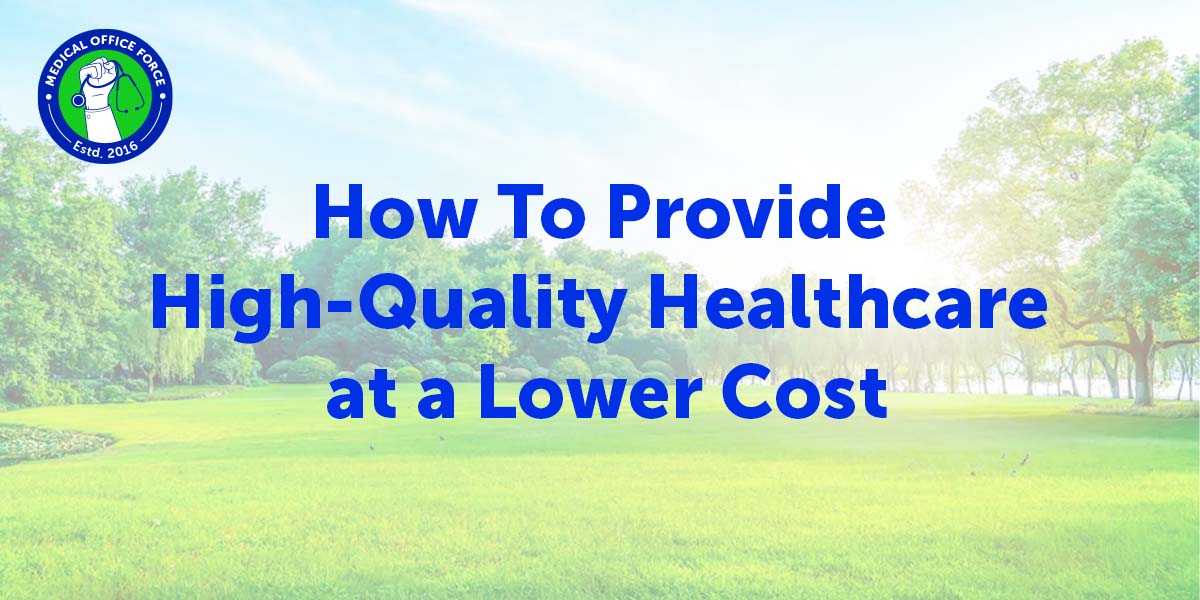
How To Provide High-Quality Healthcare at a Lower Cost
Finding a balance between providing high-quality care at a reasonable cost is both a challenge and an opportunity in today’s fast-paced healthcare landscape. With rising expenses and varying standards of care, standing out as a provider who excels in both quality and cost-efficiency is more crucial than ever.
Through innovative strategies and the smart use of technology, healthcare providers can reshape their practices to deliver outstanding patient care while keeping costs in check.
In this article, we’ll uncover actionable steps healthcare professionals can take to provide exceptional, affordable care—proving that excellence and affordability can go hand in hand.
Knowing the Fundamentals of High-Quality Healthcare
Delivering high-quality, low-cost healthcare requires a deep understanding of the core principles that define effective care. Achieving this balance hinges on prioritizing patient-centered care while maintaining efficiency and affordability within the U.S. healthcare framework.
Studies show that a focus on preventive care not only improves patient outcomes but also significantly reduces long-term costs—much like how adopting a healthy lifestyle can prevent future medical complications.
By embracing innovative practices and leveraging advanced technologies, we can streamline operations and elevate service delivery. This approach empowers us to transform the healthcare landscape, ensuring quality care is accessible and affordable for all.
Determine Which Technologies and Practices Are Cost-Effective
When thinking about cost-effective healthcare, it’s tempting to imagine teams of doctors brainstorming ways to cut expenses without sacrificing care quality. However, the path to balancing costs and excellence lies in adopting innovative, practical solutions.
Take telemedicine, for example—a modern tool that not only reduces overhead but also enhances patient access to care. Similarly, evidence-based protocols ensure consistent, high-quality treatment, often resulting in better outcomes and fewer complications. Collaborating to share resources among healthcare providers is another effective strategy to lower expenses while maintaining superior care standards.
The key to cost efficiency isn’t cutting corners—it’s making smart, patient-focused decisions that benefit both those receiving and delivering care.
Harnessing Technologies Like Remote Patient Monitoring (RPM) and Chronic Care Management (CCM)
Technologies such as Remote Patient Monitoring (RPM) and Chronic Care Management (CCM) are transforming the healthcare landscape, enabling providers to deliver exceptional care while keeping costs in check. Here’s how these tools make a difference:
Improved Patient Outcomes
RPM allows continuous, real-time monitoring of patients with chronic conditions. By tracking vital signs, symptoms, and medication adherence, healthcare providers can identify issues early and intervene promptly, preventing complications and reducing hospitalizations.
Enhanced Efficiency
CCM programs provide a structured approach to managing chronic conditions through regular check-ins, personalized care plans, and coordinated efforts. This proactive care reduces costly emergency visits and hospital admissions.
Cost Savings
By minimizing the need for in-person visits and reducing hospital readmissions, RPM and CCM substantially lower healthcare expenses. These technologies streamline care delivery, saving time and resources for both patients and providers.
Patient Engagement and Satisfaction
By providing patients with the resources and support they need to better manage their diseases, RPM and CCM actively engage patients in their health management. This fosters higher satisfaction and adherence to treatment plans, crucial for achieving optimal health outcomes.
Optimized Resource Utilization
With RPM, providers can remotely monitor multiple patients, focusing their attention on those requiring immediate care while efficiently managing stable cases. This balanced approach ensures better use of resources and time.
Together, RPM and CCM empower providers to offer personalized, high-quality care while reducing costs. By aligning with value-based care principles, these technologies ensure patients receive timely, effective treatment—proving that innovation and affordability can go hand in hand.
Cultivating a Skilled and Efficient Healthcare Team
Creating a skilled and efficient healthcare team is the cornerstone of providing exceptional, cost-effective care. Begin by investing in robust training programs designed to enhance individual expertise and foster collaboration across all roles. When team members feel valued and supported, job satisfaction and productivity naturally rise.
Incorporating advanced technologies like telemedicine and electronic health records further streamlines workflows reduces operational burdens, and allows the team to focus more on delivering excellent patient care. This integration not only saves time but also minimizes administrative tasks, promoting a more seamless care experience.
Continuous learning opportunities and ongoing support are essential to sustaining team efficiency and effectiveness. With a focus on teamwork and skill-building, you’ll be well-positioned to adopt innovative care models that emphasize patient-centered approaches—ensuring that the needs of your patients always come first.
Putting Patient-Centered Care Models into Practice
Putting patient-centered care models into practice requires careful attention to each patient’s individual needs, similar to tailoring a suit. By prioritizing the patient, healthcare providers can create personalized care experiences that enhance both clinical outcomes and patient satisfaction. Involving patients in shared decision-making empowers them to actively participate in their treatment, creating a sense of control over their health journey.
Additionally, telehealth technology expands access to care while maintaining meaningful connections between patients and providers. As these approaches are introduced, it’s essential to regularly evaluate their impact on patients, allowing for necessary adjustments and ongoing improvements. Committing to this process ensures continuous quality enhancement and a steadfast focus on patient well-being.
Assessing Performance and Improving Care Constantly
Measuring performance and continuously improving care is essential for healthcare providers focused on delivering quality, cost-effective services. Tracking key performance indicators (KPIs) helps assess areas like patient outcomes and efficiency. By analyzing data trends, we can identify strengths and areas for growth, fostering a culture of accountability and innovation among staff. Regular feedback from both patients and employees allows for real-time adjustments to better meet their needs. This commitment to improvement not only enhances patient satisfaction but also drives efficiency across the organization.
Conclusion
We can all strive to be healthcare providers who deliver both high-quality and affordable care. By implementing efficient processes, investing in our team, and prioritizing patient-centered care, we can improve outcomes and ensure the long-term sustainability of our services. This approach benefits everyone involved, especially our patients, building a healthcare environment focused on excellence and accessibility for all.

